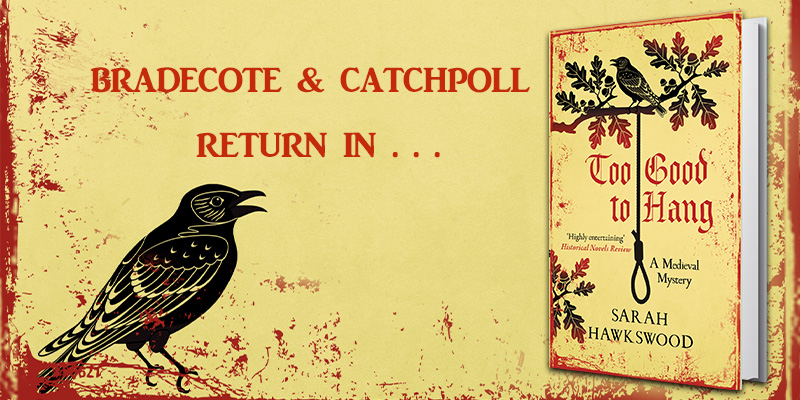Morðor heo writ / Murder She Writes – A guest blog post from Sarah Hawkswood as part of National Crime Reading Month
To celebrate National Crime Reading Month (June 2023) we will be showcasing our finest crime series from the Allison & Busby bookshelves. Each week, we will be spotlighting a different crime series and bringing you exclusive content from the authors themselves. National Crime Reading Month aims to bring crime writing, old and new, to the forefront of bookshops and libraries throughout the month of June. We are thrilled to be taking part in such a pivotal initiative in the crime writing world! This week we have a guest blog post from Sarah Hawkswood, author of the Bradecote & Catchpoll Mysteries.

Some people might think that writing 12thC crime fiction is easier than writing contemporary crime, because there are no detailed forensic techniques to master, no complexity of modern law statutes, CCTV angles or even the Police And Criminal Evidence Act 1984. Those are certainly considerations for contemporary crime writers, especially police procedurals, and in many ways my Bradecote & Catchpoll series are ‘proto-police procedurals’. Serving officers have told me they recognise ‘my boys’ as police officers in attitude, even though no such thing as ‘detectives’ existed in the 12thC.
However, being at the other end of the time scale has its own problems. The first is that the vital element of the police officer’s kit, the contemporaneous notebook, is denied to ‘my boys’ because they lived in an era when few other than monastics were literate. Men like William de Beauchamp, Sheriff of Worcestershire, had clerks who wrote what they wanted to be sent, and read out the replies to them. I have stretched a point a little so that Bradecote cannot write but can, rather laboriously, read a message. This was because to always have someone report orally smacked a little of Blackadder and ‘Sire, I bring news.’ What has even greater impact is that illiteracy means that what is said by every witness, every suspect, has to be stored in their memory, filed according to importance. This means that if they have to go back to a previous set aside line of inquiry, they have to dredge up what was said, and what validated it. The best at this is Walkelin, who has the most filing cabinet’ mind, but even he is not perfect.
There is also the constraint of a lack of forensics beyond what the eye can see, the nose can smell, and experience has taught. Serjeant Catchpoll has been Sheriff’s Serjeant over twenty years and seen many corpses, in various attitudes of death and various stages post mortem. As a writer I can only use what he would see and assess in a manner appropriate to the period. As an example, he would have seen post mortem lividity, where the blood settles after death in those areas touching the ground, or dependent. A man slung over a horse (as happened with the corpse of Richard III after the Battle of Bosworth) would have this darkening of the skin in face, hands and feet. In an era when circulation of the blood was not understood, I had to create a logical reason that Catchpoll would understand for this phenomenon, and used that the apothecaries said that it was because people were from the earth, and the blood was trying to return ‘home’ as quickly as possible.
The practical issues, including how swiftly the crime is notified and how long it takes to reach the scene, mean also that a case becomes ‘cold’ within days, and in reality many murders would remain unsolved if the local ‘hue and cry’ did not take up the obvious suspect in the domestic murder etc. It is almost a requirement for there to be at least one related death just to provide enough information for the killer to be discovered. Most ‘cases’ last no more than a week for this reason.
The motivations for murder are timeless, but in the modern world there are increasingly inventive ways to commit it, and to attempt evasion from justice. In a more simple era it is difficult to be both realistic and not repetitive. In fact it is better to accept that there will be repetition but try and make other elements give freshness to the plot.
The final element which is harder for the historical crime writer is finding the ‘voices’ for the characters. If I wrote in Late Old English/Early Modern English as was used in the mid 12thC it would be unintelligible to the vast majority – I doubt ‘Morðor heo wrat’ would have had the audience of ‘Murder She Wrote’. One has to create the best sense of period, something that can be understood but sounds unlike modern speech patterns. The advantage I now have is that it is twenty years since I first began Bradecote and Catchpoll in the first draft of the first book, and these days they write themselves. All I do is tag along and type what they say.
Contemporary crime writing is a challenge, but those of us who set our ‘cases’ in the distant past do not have an easier time, just different problems to overcome.
Click here to learn about the Bradecote & Catchpoll series.
Don’t forget to follow us on Instagram, Facebook, and Twitter to keep up with the latest news!


